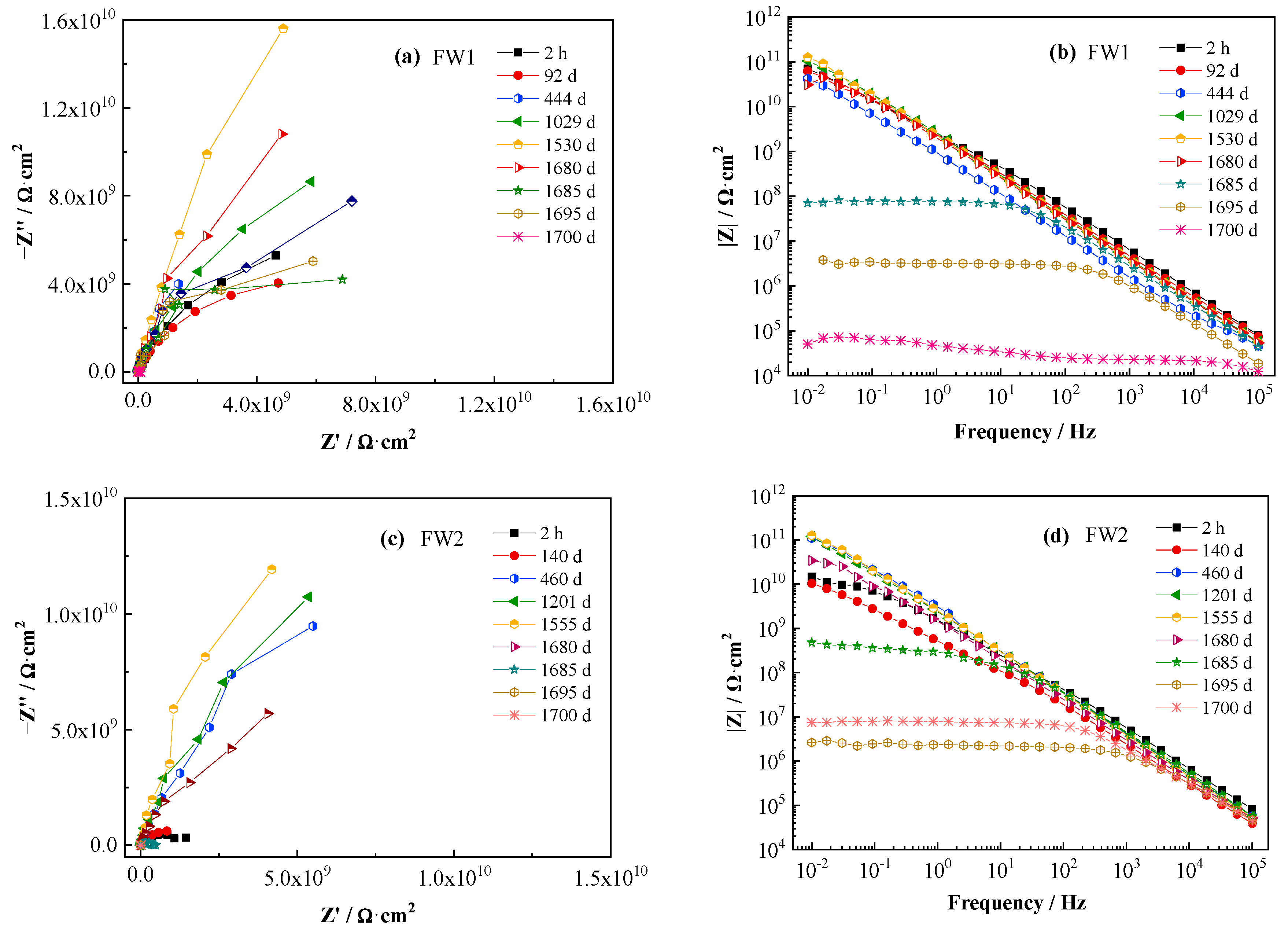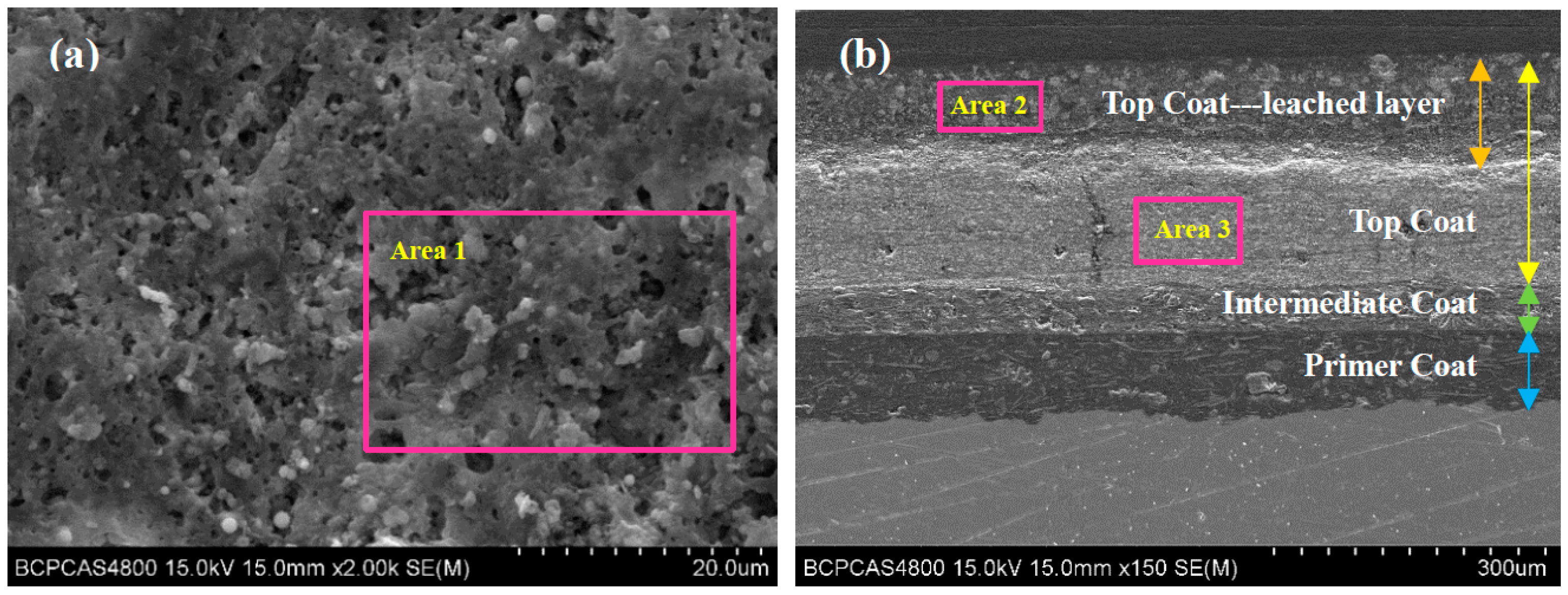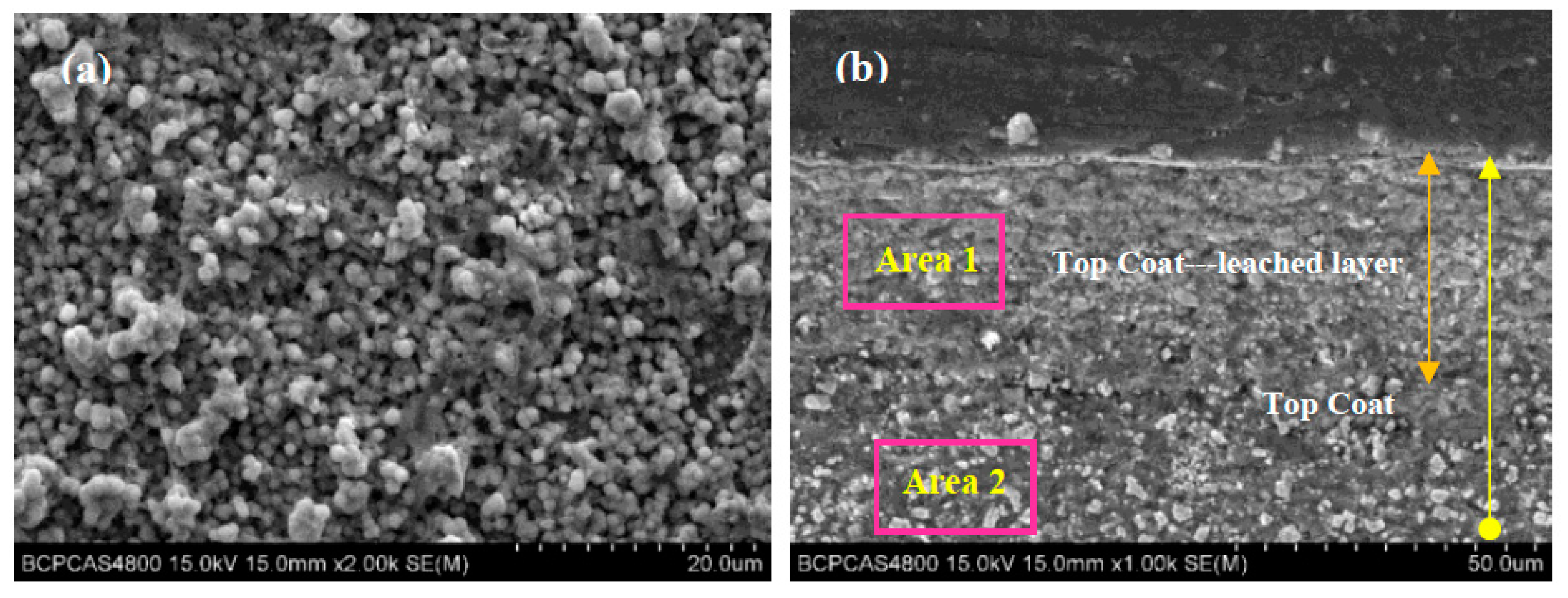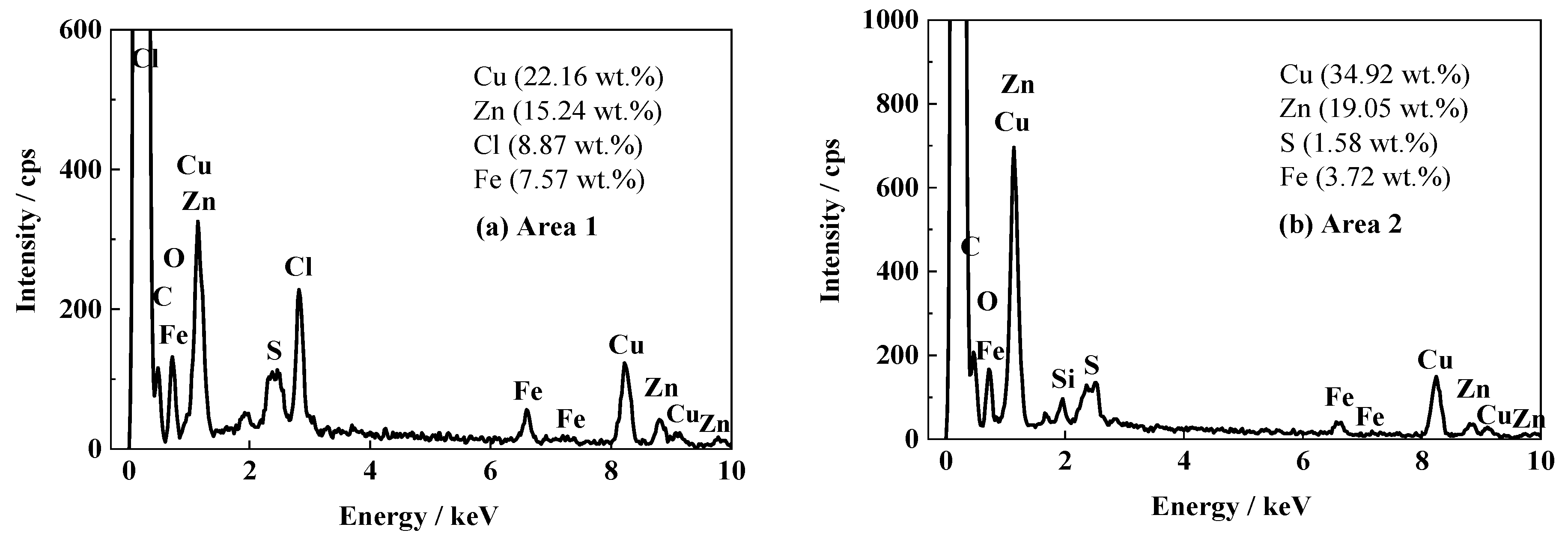Comparative Study on the Degradation of Two Self-Polishing Antifouling Coating Systems with Copper-Based Antifouling Agents
Abstract
:1. Introduction
2. Experimental
2.1. Materials and Samples Preparation
2.2. Corrosion Tests and Measurements
3. Results and Discussion
3.1. EIS Results of Two Anticorrosion and Antifouling Coating Samples in 3.5% NaCl Solution
3.2. The Microscopic Morphology and Composition Analysis of the Coating Samples
| polymer–COO–Zn (s) − X + Na+ ⇋ polymer–COO–Na+ (s) + Zn2+ + X− |
| Zn acrylate (insoluble) acidic polymer (soluble) |
3.3. The Cu Releasing of the Two Coating Samples
3.4. Infrared Test Results of Two Coating Systems
4. Conclusions
Author Contributions
Funding
Institutional Review Board Statement
Informed Consent Statement
Data Availability Statement
Conflicts of Interest
References
- Liu, C.; Ma, C.F.; Xie, Q.Y.; Zhang, G.Z. Self-repairing silicone coatings for marine anti-biofouling. J. Mater. Chem. A 2017, 5, 15855–15861. [Google Scholar] [CrossRef]
- Chambers, L.D.; Stokes, K.R.; Walsh, F.C.; Wood, R.J.K. Modern approaches to marine antifouling coatings. Surf. Coat. Technol. 2006, 201, 3642–3652. [Google Scholar] [CrossRef]
- Paz-Villarraga, C.A.; Castro, Í.B.; Fillmann, G. Biocides in antifouling paint formulations currently registered for use. Environ. Sci. Pollut. Res. 2022, 29, 30090–30101. [Google Scholar] [CrossRef]
- Detty, M.R.; Ciriminna, R.; Bright, F.V.; Pagliaro, M. Environmentally benign sol-gel antifouling and foul-releasing coatings. Acc. Chem. Res. 2014, 47, 678–687. [Google Scholar] [CrossRef] [PubMed]
- Fu, Y.; Du, H.; Chen, Z.J.; Liu, X.; Zhang, X.D. Preparation and performance of new antifouling resins containing BIT group. J. Adhes. Sci. Technol. 2019, 33, 93–109. [Google Scholar] [CrossRef]
- Yu, X.Y.; Wang, K.; Chen, Z.T.; Yu, H.J.; Xiao, L.; Gui, T.J. Research on leaching rate & degradation behavior of Cu2O contained in antifouling paints. Paint. Coat. Ind. 2012, 42, 45–52. (In Chinese) [Google Scholar]
- Bressy, C.; Hellio, C.; Nguyen, M.N.; Tanguy, B.; Maréchal, J.; Margaillan, A. Optimized silyl ester diblock methacrylic copolymers: A new class of binders for chemically active antifouling coatings. Prog. Org. Coat. 2014, 77, 665–673. [Google Scholar] [CrossRef]
- Grunnet, K.S.; Dahllöf, I. Environmental fate of the antifouling compound zinc pyrithione in seawater. Environ. Toxicol. Chem. 2005, 24, 3001–3006. [Google Scholar] [CrossRef]
- Cima, F.; Varello, R. Potential disruptive effects of copper-based antifouling paints on the biodiversity of coastal macrofouling communities. Environ. Sci. Pollut. Res. 2022. [Google Scholar] [CrossRef]
- Hunsucker, K.Z.; Gardener, H.; Lieberman, K.; Swain, G. Using hydrodynamic testing to assess the performance of fouling control coatings. Ocean Eng. 2019, 194, 106677. [Google Scholar] [CrossRef]
- Punitha, N.; Saravanan, P.; Mohan, R.; Ramesh, P.S. Antifouling activities of β-cyclodextrin stabilized peg based silver nanocomposites. Appl. Surf. Sci. 2017, 392, 126–134. [Google Scholar] [CrossRef]
- Bressy, C.; Margaillan, A. Erosion study of poly(trialkylsilyl methacrylate)-based antifouling coatings. Prog. Org. Coat. 2009, 66, 400–405. [Google Scholar] [CrossRef]
- Tribou, M.; Swain, G. The effects of grooming on a copper ablative coating: A six year study. Biofluling 2017, 33, 494–504. [Google Scholar] [CrossRef] [PubMed]
- Yebra, D.M.; Kiil, S.; Johansen, K.D. Antifouling technology−past, present and future steps towards efficient and environmentally friendly antifouling coatings. Prog. Org. Coat. 2004, 50, 75–104. [Google Scholar] [CrossRef]
- Bressy, C.; Hugues, C.; Margaillan, A. Characterization of chemically active antifouling paints using electrochenmical impedance spectrometry and erosion tests. Prog. Org. Coat. 2009, 64, 89–97. [Google Scholar] [CrossRef]
- Faÿ, F.; Horel, G.; Linossier, I.; Vallée-Réhel, K. Effect of biocidal coatings on microfouling: In vitro and in situ results. Prog. Org. Coat. 2018, 114, 162–172. [Google Scholar] [CrossRef]
- Valkirs, A.O.; Seligman, P.F.; Hasleck, E.; Caso, J.S. Measurement of copper release rates from antifouling paint under laboratory and in situ conditions: Implications for loading estimation to marine water bodies. Mar. Pollut. Bull. 2003, 46, 763–779. [Google Scholar] [CrossRef]
- Dai, Z.W.; Cao, M.; Li, S.Q.; Yao, J.H.; Wu, B.; Wang, Y.P.; Wang, H.J.; Dong, J.; Yi, J. A novel marine antifouling coating based on a self-polishing zinc-polyurethane copolymer. J. Coat. Technol. Res. 2021, 18, 1333–1343. [Google Scholar] [CrossRef]
- Wang, S.; Liu, X.J.; Yu, L.M.; Zhao, Y.; Sun, M.L. Low surface energy self-polishing polymer grafted MWNTs for antibacterial coating and controlled-release property of Cu2O. J. Appl. Polym. 2021, 138, 50267. [Google Scholar] [CrossRef]
- Turley, P.A.; Fenn, R.J.; Ritter, J.C.; Callow, M.E. Pyrithiones as antifoulants: Environmental fate and loss of toxicity. Biofouling 2005, 21, 31–40. [Google Scholar] [CrossRef]
- Pavlacky, D.A.; Gelling, V.J.; Ulven, C.A. The use of electrochemical impedance spectroscopy to monitor delaminations in polymer matrix composites: A review. Int. J. Mater. Sci. 2011, 1, 23–29. [Google Scholar] [CrossRef]
- Peres, R.S.; Armelin, E.; Moreno-Martínez, J.A.; Alemán, C.; Ferreira, C.A. Transport and antifouling properties of papain-based antifouling coatings. Appl. Surf. Sci. 2015, 341, 75–85. [Google Scholar] [CrossRef]
- Thomas, K.A.; Nair, S.; Rajeswari, R.; Ramesh Kumar, A.V.; Natarajan, V.; Mukunda, T.; John, R. Electrochemical behaviour of PANi/polyurethane antifouling coating in salt water studied by electrochemical impedance spectroscopy. Prog. Org. Coat. 2015, 89, 267–270. [Google Scholar] [CrossRef]
- Chasse, K.R.; Scardino, A.J.; Swain, G.W. Corrosion and fouling study of copper-based antifouling coatings on 5083 aluminum alloy. Prog. Org. Coat. 2020, 141, 105555. [Google Scholar] [CrossRef]
- Zhu, B.F.; Liu, Z.H.; Liu, J.; Yang, Y.M.; Meng, Y.B.; Yu, F.; Jiang, L.; Wei, G.Y.; Zhang, Z. Preparation of fluorinated/silanized polyacrylates amphiphilic polymers and their anticorrosion and antifouling performance. Prog. Org. Coat. 2020, 140, 105510. [Google Scholar] [CrossRef]
- GB/T 6824-2008; Determination for Release Rate of Cupper-Ion for Antifouling Paint on Ship Bottom. GB/T: Beijing, China, 2008. (In Chinese)
- Champ, M.A. A review of organotin regulatory strategies, pending actions, related costs and benefits. Sci. Total Environ. 2000, 258, 21–71. [Google Scholar] [CrossRef]
- Touzain, S.; Thu, Q.L.; Bonnet, G. Evaluation of thick organic coatings degradation in seawater using cathodic protection and thermally accelerated tests. Prog. Org. Coat. 2005, 52, 311–319. [Google Scholar] [CrossRef]
- Perrin, F.X.; Merlatti, C.; Aragon, E.; Margaillan, A. Degradation study of polymer coating: Improvement in coating weatherability testing and coating failure prediction. Prog. Org. Coat. 2009, 64, 466–473. [Google Scholar] [CrossRef]
- Olsen, S.M.; Pedersen, L.T.; Hermann, M.H.; Kiil, S.; Dam-Johansen, K. Inorganic precursor peroxides for antifouling coatings. J. Coat. Technol. Res. 2009, 6, 187–199. [Google Scholar] [CrossRef]
- KiiL, S.; Dam-Johansen, K. Characterization of pigment-leached antifouling coatings using BET surface area measurements and mercury porosimetry. Prog. Org. Coat. 2007, 60, 238–247. [Google Scholar] [CrossRef]
- Yebra, D.M.; KiiL, S.; Weinell, C.E.; Dam-Johansen, K. Dissolution rate measurements of sea water soluble pigments for antifouling paint: ZnO. Prog. Org. Coat. 2006, 56, 327–337. [Google Scholar] [CrossRef]
- Tian, W.L.; Meng, F.D.; Liu, L.; Li, Y.; Wang, F.H. The failure behaviour of a commercial highly pigmented epoxy coating under marine alternating hydrostatic pressure. Prog. Org. Coat. 2015, 82, 101–112. [Google Scholar] [CrossRef]
- Yonehara, Y.; Yamashita, H.; Kawamura, C.; Iton, K. A new antifouling paint based on a zinc acrylate copolymer. Prog. Org. Coat. 2001, 42, 150–158. [Google Scholar] [CrossRef]
- Kiil, S.; Dam-Johansen, K.; Weinell, C.E.; Pedersen, M.S. Seawater-soluble pigments and their potential use in self-polishing antifouling paints: Simulation-based screening tool. Prog. Org. Coat. 2002, 45, 423–434. [Google Scholar] [CrossRef]
- Almeida, E.; Diamantino, T.C.; Sousa, O. Marine paints: The particular case of antifouling paints. Prog. Org. Coat. 2007, 59, 2–20. [Google Scholar] [CrossRef]
- Vetere, V.F.; Pérez, M.C.; Romagnoli, R.; Stupak, M.E.; Amo-Cidepint, B.D. Solubility and toxic effect of the cuprous thiocyanate antifouling pigment on barnacle larvae. J. Coat. Technol. 1997, 69, 39–45. [Google Scholar] [CrossRef]
- Ammar, S.; Ramesh, K.; Azman, N.A.N.; Vengadaesvaran, B.; Ramesh, S.; Arof, A.K. Comparison studies on the anticorrosion and overall performance of solvent/water based epoxy-copper reinforced composite coatings. Mater. Express 2016, 6, 403–413. [Google Scholar] [CrossRef]
- Karadeniz, K.; Çalıkoğlu, Y.; Sen, M.Y. A novel polyurethanes from epoxidized soybean oil synthesized by ring opening with bifunctional. Polym. Bull. 2017, 74, 2819–2839. [Google Scholar] [CrossRef]
- Matin, E.; Attar, M.M.; Ramezanzadeh, B. Investigation of corrosion protection properties of an epoxy nanocomposite loaded with polysiloxane surface modified nanosilica particles on the steel substrate. Prog. Org. Coat. 2015, 78, 395–403. [Google Scholar] [CrossRef]
- Samui, A.B.; Chavan, J.G.; Hande, V.R. Study on film forming organo-copper polymer. Prog. Org. Coat. 2006, 57, 301–306. [Google Scholar] [CrossRef]
- Yang, H.F.; Sheng, X.M.; Li, Y.C.; Xiao, F.J. Preparation of cuprous thiocyanate nanoparticles for marine antifouling paint. J. Chin. Ceram. Soc. 2006, 34, 1456–1460. (In Chinese) [Google Scholar]
- Silva, E.R.; Ferreira, O.; Ramalho, P.A.; Azevedo, N.F.; Bayón, R.; Igartua, A.; Bordado, J.C.; Calhorda, M.J. Eco-friendly non-biocide-release coatings for marine biofouling prevention. Sci. Total Environ. 2019, 650 Pt 2, 2499–2511. [Google Scholar] [CrossRef] [PubMed]
- Perrin, F.X.; Irigoyen, M.; Aragon, E.; Vernet, J.L. Evaluation of accelerated weathering tests for three paint systems: A comparative study of their aging behaviour. Polym. Degrad. Stab. 2001, 72, 115–124. [Google Scholar] [CrossRef]
- Yang, X.F.; Vang, C.; Tallman, D.E.; Bierwagen, G.P.; Croll, S.G.; Rohlik, S. Weathering degradation of a polyurethane coating. Polym. Degrad. Stab. 2001, 74, 341–351. [Google Scholar] [CrossRef]
- Mao, T.Y.; Lu, G.; Xu, C.Y.; Yu, H.W.; Yu, J.L. Preparation and properties of polyvinylpyrrolidone-cuprous oxide microcapsule antifouling coating. Prog. Org. Coat. 2020, 141, 105317. [Google Scholar] [CrossRef]









| Number | Coating System | Thickness/μm |
|---|---|---|
| AF1 | H900X-1 high build epoxy primer | 80 ± 5 |
| H838 epoxy intermediate coating | 40 ± 5 | |
| 859 self-polishing antifouling coating | 240 ± 10 | |
| AF2 | H900X-1 high build epoxy primer | 80 ± 5 |
| H838 epoxy intermediate coating | 40 ± 5 | |
| 889 self-polishing antifouling coating | 240 ± 10 |
| Wavenumber (cm−1) | Assignment | Literatures |
|---|---|---|
| 3410−3430 | Hydroxyl (O–H) | [38,39,40] |
| 2923, 2854 | methylene(–CH2) | [33,38,39,40,41] |
| 2165 | C≡N in SCN− | [42,43] |
| 1725 | C=O in esters | [29,33,41,43] |
| 1610, 1506 | Phenyl groups | [33] |
| 1443 | –CH2 bending vibration | [39,41,44] |
| 1243,1020 | Etheric band (C–O–C) | [33,40,44,45] |
| 1148 | C–O in ester | [39] |
| 885, 825 | Epoxide ring | [33,38] |
| 752 | CH2 rocking vibration | [39] |
| 623 | Cu–O | [46] |
Publisher’s Note: MDPI stays neutral with regard to jurisdictional claims in published maps and institutional affiliations. |
© 2022 by the authors. Licensee MDPI, Basel, Switzerland. This article is an open access article distributed under the terms and conditions of the Creative Commons Attribution (CC BY) license (https://creativecommons.org/licenses/by/4.0/).
Share and Cite
Zhang, H.; Cao, J.; Sun, L.; Kong, F.; Tang, J.; Zhao, X.; Tang, Y.; Zuo, Y. Comparative Study on the Degradation of Two Self-Polishing Antifouling Coating Systems with Copper-Based Antifouling Agents. Coatings 2022, 12, 1156. https://doi.org/10.3390/coatings12081156
Zhang H, Cao J, Sun L, Kong F, Tang J, Zhao X, Tang Y, Zuo Y. Comparative Study on the Degradation of Two Self-Polishing Antifouling Coating Systems with Copper-Based Antifouling Agents. Coatings. 2022; 12(8):1156. https://doi.org/10.3390/coatings12081156
Chicago/Turabian StyleZhang, Hanlu, Jingyi Cao, Li Sun, Fabao Kong, Jianhua Tang, Xuhui Zhao, Yuming Tang, and Yu Zuo. 2022. "Comparative Study on the Degradation of Two Self-Polishing Antifouling Coating Systems with Copper-Based Antifouling Agents" Coatings 12, no. 8: 1156. https://doi.org/10.3390/coatings12081156






